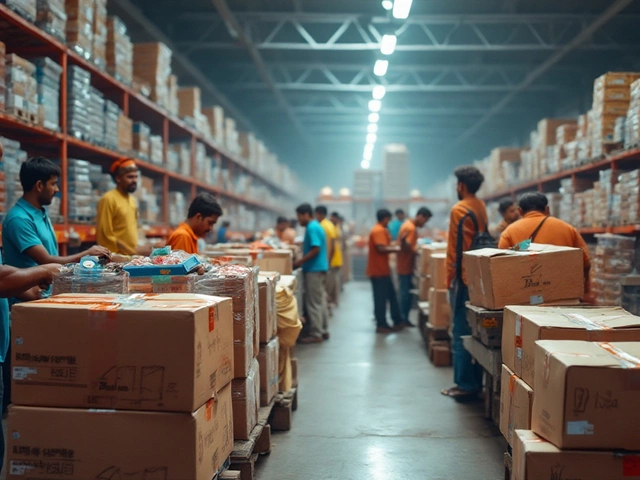Shipping stuff internationally can feel like solving a jigsaw puzzle. One piece of that puzzle is choosing the right box. Ever wondered if using your own box is cheaper? It sounds simple, but there's more to it than meets the eye.
First off, knowing how shipping costs work is crucial. Carriers often base their rates on a mix of size, weight, and destination. So, even if you've got a box at home, it must align with these factors to save you some bucks. Otherwise, it's all too easy to get hit with unexpected fees.
Now, carriers have their own guidelines, and let me tell you, they're not shy about extra charges. If your box doesn't fit into their size and weight brackets, you might end up paying more than you bargained for. So, while your old shoebox might work for a gift to grandma, it could surprise your wallet when shipping abroad.
- Understanding Shipping Costs
- Pros and Cons of Using Your Own Box
- Carrier Restrictions and Guidelines
- Packaging Tips for Cost Efficiency
- Case Studies and Real Experiences
Understanding Shipping Costs
When it comes to international shipping, costs can add up faster than you'd expect. To get to the bottom of it, imagine you're putting together a puzzle. Each piece counts, and if one is off, the whole picture can get distorted.
Key Factors Affecting Costs
Shipping expenses usually revolve around three major elements: size, weight, and destination. Most carriers, like FedEx, UPS, or DHL, follow these factors to set their prices:
- Size: The dimensions of your package. Often, if your box is too big, even if it's light, you might pay more because it takes up more space in the truck or plane.
- Weight: How heavy your package is. It’s pretty straightforward—the heavier it is, the more you'll likely pay.
- Destination: Farther destinations usually mean higher costs. Sending something to Greenland will probably cost more than shipping something across the border to Mexico.
Additionally, many carriers have what's known as a 'dimensional weight' pricing scheme. This means they calculate shipping costs based on the volume of the box relative to its weight. It's a way for airlines to ensure they’re making the most of their cargo space.
Extra Fees and Surcharges
Aside from the main factors, keep an eye out for hidden fees. These could include:
- Fuel Surcharges: A fluctuating fee based on current fuel prices. It's like the weather—constantly changing but always there.
- Customs Duties: Depending on the value and type of goods you're shipping, destination countries might add extra charges to allow your package through their borders.
- Handling Fees: Some carriers charge extra for handling special items like perishables or fragile goods.
| Cost Factor | Impact |
|---|---|
| Size | Can increase costs significantly if the box is too large |
| Weight | Higher costs with greater weight |
| Destination | Farther destinations often mean higher prices |
Understanding these elements will help you make smarter decisions when choosing your packaging. Embrace these factors, and you could save a fair amount on your shipping spend.
Pros and Cons of Using Your Own Box
When you're shipping internationally, the question of whether to use your own box can be a real head-scratcher. Let's break down the pros and cons to help make that decision a little easier.
Pros of Using Your Own Box
Cost Savings: One of the biggest perks is the potential for cutting costs. If you've got boxes lying around at home, it might save you from buying pricey packaging from a carrier. Plus, using a box that fits snugly around your items can mean lower dimensional weight charges.
Convenience: Got a box that’s the perfect fit? No need to go hunting for packaging at the last minute. Just pack it up and you’re good to go.
Eco-Friendly: Reusing boxes is a more sustainable option than constantly buying new packaging, reducing your carbon footprint one shipment at a time.
Cons of Using Your Own Box
Size and Weight Restrictions: Carriers have strict size and weight guidelines. If your box doesn’t fit within these, you might face extra fees. Check the carrier's rules before sealing that box.
Durability Concerns: An old box might not be up to the task, especially for long journeys. Make sure your box is sturdy enough to protect your items during transit.
Lack of Branding: If you’re running a business, using your own box may miss out on the professional look of branded packaging. This might not be an issue for personal shipments, but it’s something to consider for commercial purposes.
Deciding whether to use your own box really boils down to balancing cost savings against possible risks. Be mindful of the carrier restrictions and the nature of what you’re shipping. With a bit of thought, you can make a choice that suits your needs and your wallet.

Carrier Restrictions and Guidelines
When it comes to international shipping, each carrier has its own set of rules. Understanding these can save you from surprise costs. Carriers like FedEx, UPS, and DHL are super picky about box sizes and weights. If you go over their limits, you'll encounter extra fees, even if it's by just an inch or an ounce.
Size and Weight Restrictions
Understanding Sizes
Most carriers use something called dimensional weight to calculate shipping costs. This method considers the size of your package, not just its weight. So, a large, lightweight package might cost more than a small, heavy one. For example, UPS and FedEx often measure in inches and weight in pounds. If your package exceeds their maximum dimensions or weight, brace yourself for a 'large package' surcharge.
Weight Considerations
Each carrier has a maximum weight limit. For instance, UPS sets 150 lbs as the cap, while FedEx allows up to 150 lbs too. Going over means not only a hefty fee but potentially delayed deliveries. Better to keep all weights written down clearly and precisely.
Packaging Guidelines
- Use a sturdy box that meets the carrier's standards.
- Seal your package properly using heavy-duty tape. Most carriers don't appreciate duct tape.
- Include padding like bubble wrap or foam peanuts to protect your contents.
Carriers often provide free tools and calculators on their websites to help with these logistics. Make good use of these tools to avoid missteps.
Finally, keeping up with these guidelines can help avoid overcharges and ensure your items arrive safely. Pay close attention to both box and contents to save both cash and headaches.
Packaging Tips for Cost Efficiency
If you're shipping internationally and want to save money, packaging wisely is the key. And don't just focus on finding any box; the right box matters.
Choosing the Right Box
The size of your box should closely fit your item to avoid unnecessary extra fees. Excessively large boxes ups the dimensional weight the carrier charges you for. Try to use boxes that are sturdy but not overkill; remember, it's just packaging.
"Efficient packaging is about striking a balance between protecting goods and optimizing size," explains Mark Shively, a logistics expert from Global Trade Review.
Use Quality Materials
Sure, using your own box is great, but it must be up to the task. Flimsy boxes lead to damages or additional wrapping materials. Find ones that are durable enough to protect your items without being too heavy.
- Opt for double-walled cardboard for heavier items.
- For delicate stuff, use bubble wrap or soft padding.
- Secure with high-quality packing tape to avoid mishaps en route.
Seal the Deal with Correct Labeling
Don't underestimate the power of proper labeling. Incorrect labels can lead to delivery issues or even return fees. Make sure the address is clear and visible, with nothing blocking vital info.
Thinking about saving some cents? Here's an idea—get your packaging materials in bulk. Although it's a small initial investment, bulk buys knock down costs over time. Many experienced shippers swear by it.
For those keen on getting really savvy, understanding carrier-specific size calculations can save you a bundle. Just ensure your package fits snuggly within the specs, keeping those extra charges at bay and your international shipping costs efficient.

Case Studies and Real Experiences
Everyone's got a story when it comes to shipping internationally. Let's dive into some real-life case studies of folks who tried to use their own boxes—and how it impacted their shipping costs.
Case Study 1: The Small Business Owner
Meet Sarah, a small business owner selling handcrafted mugs overseas. To save on costs, she used her own boxes—sturdy ones she got at a local store. However, when she took them to her carrier, she learned they exceeded the dimension limits for the standard price bracket. The result? A significant surcharge, nearly 25% more than if she had used the company's own shipping boxes.
Case Study 2: The Family Gift
John wanted to surprise his sister in Spain with a care package filled with homemade goodies. Using a box he found at home seemed like a no-brainer. What he didn't realize was that carriers often weigh packages using the higher of the actual weight or volumetric weight (size). His thoughtfully packed, but oversized, box incurred unexpected fees that almost doubled his original budget.
Case Study 3: Learning from Experience
On the flip side, Laura, a DIY furniture seller, researched shipping guidelines for each international order. She judges the package dimensions herself to avoid any extra charges. Laura found that buying bulk standard-sized boxes that fit within carrier limits, even if slightly more expensive upfront, saves her money and headache over time.
Curious about how much size and weight can impact your shipping costs? Here's a quick rundown of average surcharges based on different delivery companies:
| Carrier | Oversize Surcharge | Overweight Surcharge |
|---|---|---|
| FedEx | $90 | $100 |
| UPS | $95 | $110 |
| DHL | $75 | $85 |
These real-world examples show that while using your own box can sometimes be a great idea, it requires understanding your shipping costs and carrier restrictions to truly save money in the long run. Each experience serves as a gentle reminder: it's not just about the box you choose, but how you navigate the shipping rules.





